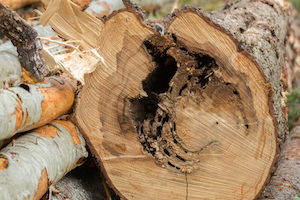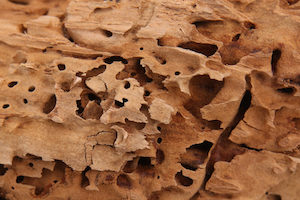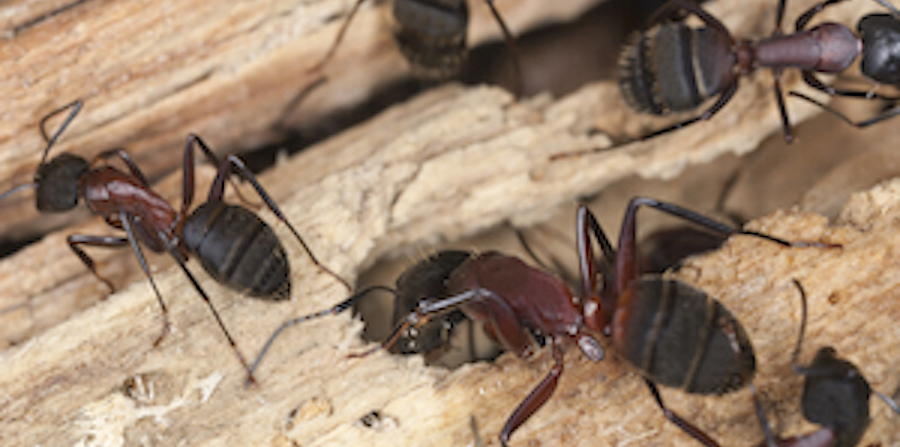It can be hard to tell regular ants from carpenter ants. Chances are you’ve seen carpenter ants or even had them in your home without realizing it! Although they may seem like regular ants, carpenter ants can pose a threat to your home.
Most carpenter ant infestations happen in the spring and late fall. If you find carpenters in your home during cold months, it’s probably because they’ve taken up residence. Carpenters can do significant structural damage over time, so it’s important to find and deal with them quickly. Here’s everything you need to know about how to get rid of carpenter ants in fall and all year-round.
Carpenter Ants 101
Carpenter ants are one of the largest and most prevalent ants in Michigan. Most species resemble a larger version of a regular ant. They come in a variety of colors including combinations of black, red, dull yellow, grey, or brown. Adult specimens are usually between ¼ and ½ inches long. Carpenters may resemble termites, but they have darker bodies, narrower waists, bent antennae, and a rounded thorax.
Colonies of carpenters are divided into castes, each with different distinguishing characteristics and sizes. Worker carpenter ants have large mandibles or pincers. Swarmer ants have two sets of wings–hind wings and front wings – and are the reproducers of the species. A female swarmer will become a carpenter ant queen and be solely responsible for populating the hive with workers.
Carpenters remain a problem because their colonies can grow large quickly. Large colonies can inflict structural damage on homes in relatively short periods of time.
Where to Look for Carpenter Ants

Carpenter ants gnaw the wood they want to move into a compact, sawdust-like material. Spotting this transported wood dust is one of the only reliable ways to find carpenter ants. Be careful, hollowed out wood takes on a dry, smooth, almost sandpaper-like appearance and may collapse under strain.
Outside, carpenter ants usually build colonies in wood that’s already been hollowed out. Most outdoor “parent” colonies are found in rotting trees, tree stumps, roots, fallen logs, or other decaying wood. As colonies expand, they require “satellite” colonies to continue to support a growing population. These expansion efforts are usually what brings carpenter ants into a house in fall and spring.
Carpenter ants prefer to inhabit areas with poor air circulation, access to soil and the outdoors, and condensation. During fall, carpenter ants want to nest in areas where they can keep warm. You’ll probably find them in your
- Basement
- Attic
- Crawl space
- Foundation
- Roof
- Porch
- Doors and windows
- Wood chips
- Older siding
What Carpenter Ants eat

Unlike termites, carpenter ants don’t eat the wood they infest. Instead, these ants subsist on proteins and sugars, which they obtain from a wide variety of sources including:
- Insects
- Meat
- Pet food
- Syrup
- Honey
- Grains
- Jelly
Carpenter ants are opportunists and will eat almost anything else they can find. They’re particularly attracted to the honeydew secreted by aphids and scale insects.
Worker ants have been known to forage up to 100 yards away from their colonies to find food. The workers bring any food they find back to the colony, where it’s distributed among all members.
Carpenter ants also require a source of moisture to keep hydrated. Usually, a carpenter ant colony will establish its main nest near some source of moisture outside. Satellite nests need moisture, too, but not to the same extent as the main nest does.
Why do they want to get into my home?

In the fall, carpenter ants seek food, shelter and ideal building conditions.
Carpenter ants prefer to make their colonies in moist, soft wood. Moist wood provides enough water to sustain the colony while they expand. Soft wood is easier to chew through, allowing for faster expansion. Rotting or damaged wood is an ideal nesting site for carpenter ants. If you see carpenter ants inside during fall, they’re probably establishing a satellite colony in wood inside your home.
Do Carpenter Ant Bites Hurt?
Carpenter ants will bite in self-defense. Their larger size and strong mandibles make carpenter ant bites potentially painful. They can also spray formic acid into bites, causing further pain.
If you are bitten, keep the bite clean and treat inflammation with ice. If you experience a severe reaction, see a physician immediately.
How can I keep them away?

Remove any environment that carpenter ants are likely to nest in. Look for mold growth and decaying and/or damaged wood, particularly near the ground level. Pull out and replace any rotten siding, rip out old baseboards and trimming, and look for condensation buildup. Pay particular attention to the foundation, siding and trim in your basement. Keep a close eye out for wood damage and have it repaired as soon as you notice it.
A leaky pipe in your basement might be creating an ant utopia. Look for any plumbing leaks and repair them as soon as possible. Even if you don’t have leaks, check to make sure excess humidity isn’t creating condensation on pipes or walls. If it is, consider investing in a dehumidifier, or least check for drafts.
If you have ants already, your best method of eliminating them is to have a pest control technician locate and eliminate the nest with an insecticide.
Michigan Ant Control for Home and Business
If you need some help managing a carpenter ant problem this fall or any time of year, give Griffin a call today. We’ll be able to tell you where the ants are, how they got in, why they want to be there, and how to get rid of them. A safer, more enjoyable winter is just one phone call away.






 Most of the heat that escapes from homes leaks out of gaps around door and window frames. Rodents can feel this warm air escaping from outside, and they can follow it back to its source. Mice and rats are notorious for their ability to
Most of the heat that escapes from homes leaks out of gaps around door and window frames. Rodents can feel this warm air escaping from outside, and they can follow it back to its source. Mice and rats are notorious for their ability to  Your home transfers outdoor air in and out from more places than you’d think. Pretty much every water-using appliance needs to have a
Your home transfers outdoor air in and out from more places than you’d think. Pretty much every water-using appliance needs to have a  While you’re out checking your vent covers, take a look around the foundation of your home. Look for cracks where you can see light from inside, or where you can feel heat escaping. Pay special attention to areas of the home where utilities like water and gas enter the building. These access points tend to have gaps juuust wide enough for rodents to enter.
While you’re out checking your vent covers, take a look around the foundation of your home. Look for cracks where you can see light from inside, or where you can feel heat escaping. Pay special attention to areas of the home where utilities like water and gas enter the building. These access points tend to have gaps juuust wide enough for rodents to enter.  You didn’t think you’d get away with only cleaning the outdoors, did you? Sorry, but once you’re finished de-cluttering your yard, it’s time to move inside. Messy basements and attics attract rodents looking for warm, dark, and hidden places. The more space they have to move around in secret, the more attractive your home will look to them. One of the best ways to make sure rats leave you alone is just to demonstrate that you know they’re there.
You didn’t think you’d get away with only cleaning the outdoors, did you? Sorry, but once you’re finished de-cluttering your yard, it’s time to move inside. Messy basements and attics attract rodents looking for warm, dark, and hidden places. The more space they have to move around in secret, the more attractive your home will look to them. One of the best ways to make sure rats leave you alone is just to demonstrate that you know they’re there. 



